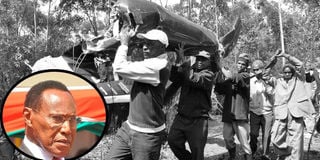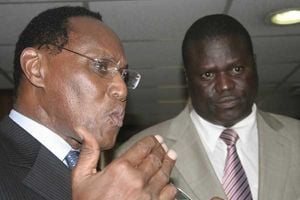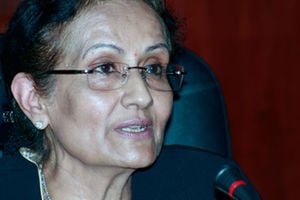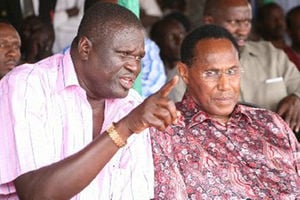
Wananchi carry the wreckage of a police plane that crashed in Ngong forest on June 10, 2012, killing former Internal Security Minister George Saitoti (inset) his assistant Orwa Ojodeh and four others.
It should have been an uneventful flight as the veteran pilot and his VIP passenger flew in a helicopter on the morning of Sunday, June 10, 2012.
Except that this particular 10am flight would be anything but routine.
And the dramatic events that fateful day would thrust Major (rtd) Charles Munyeki Wachira in the spotlight of a controversial air accident investigation into a national tragedy.
Pilot Wachira had taken off from Nakuru and stopped over at Naivasha to pick up Ms Ida Odinga, the wife of the then-prime minister Raila Odinga.
The helicopter took off for the final leg of the flight- Nairobi’s Wilson Airport. Ms Odinga was a guest during a fundraiser at a church in Embakasi.
As Wachira overflew Limuru, he radioed Wilson Airport for entry clearance. The air traffic controllers gave him the green light.
But they also asked him about the weather in Limuru. Wachira didn’t think much about the inquiry, which he interpreted as seeking an advisory. He reported the flying conditions were fine.
Over Kabete area, Wachira contacted the tower to report that visibility was very poor towards Racecourse and Ngong Hills.
It was cloudy and misty. As the pilot prepared to navigate the treacherous conditions, the reason for the constant weather updates became clear.
Aida alerted him to the breaking news on her mobile phone.
Internal Security Minister George Saitoti had been killed in a helicopter crash at Kibiko in Ngong forest.
Mr Saitoti and his deputy, Orwa Ojode, died when their police helicopter, Eurocopter AS-350B3, went down shortly before 9am. Officials manning the control tower at the airport reported they had lost contact with the two pilots six minutes after takeoff.
Also killed in the chopper crash were the two pilots- Luke Oyugi and Nancy Gituanja- and two police officers- Joshua Tonkei and Thomas Murimi.
Wilson Airport
Oyugi and Gituanja collectively had over 15 hours in the AS-350 model.
It’s not until Wachira had landed at Wilson Airport that he received an official communication regarding the ill-fated aircraft registration 5Y-CDT.
For Wachira, the loss was even more personal. Oyugi and Gituanja were his aviation students. He had assessed them four months earlier for a routine pre-flight test.
A certified instructor and Kenya Civil Aviation Authority- approved general flight test examiner, Wachira had since 1990 regularly checked out pilots.
Check out involves assessing the pilot’s knowledge of a particular type of aircraft, both in theory and practically during a test flight.
The Kenya Police Air wing had tapped him to evaluate its pilots on their competence in the cockpit of an AS 350 helicopter.
“I flew the first AS 350 in the country. To qualify to check out pilots on the AS 350, I have to have that type rating on my license, be an instructor and also be appointed as an approved general test examiner by KCAA,” Wachira stated in a report dated September 10, 2012, handed to a commission that investigated the Saitoti plane crash.
An officer from KCAA’s licensing department had contacted him to book the tests for the two pilots.
At the Kenya Police Air wing, Wachira had assessed Gituanja and Oyugi, separately, on January 24 and February 15, 2012, respectively. Both had passed the flight test.
By the time of the check out, Gituanja had done approximately 448 flight hours. These included 4h20 on the AS 350 during her training in South Africa between November 28 and December 1, 2011.
As for Oyugi, by the time of check out, he had cumulatively flown 533 hours. These included about 10 hours on the AS 350 under the commandant of the Kenya Police Air wing.
It’s on the backdrop of these interactions with the two young pilots that their deaths particularly hit Wachira hard.
And when the government established a public inquiry into the fatal crash, Wachira was named a member of the team.
Lady Justice Kalpana Rawal, then a judge of Appeal, was named chairperson of the team. The other assessors were Wachira, Maj-Gen (Rtd.) Harold Tangai, Capt Peter Maranga, Fred Opot, Faith Irari and James Warui.
Clatus Macowenga was named the technical assistant, according to a special issue of the gazette notice published by the then Minister for Transport, Amos Kimunya, on June 20, 2012.
Wachira had prior experience in air accident investigations. He was a commissioner in a team appointed in 1996 by then President Moi to inquire into another police helicopter crash in Marsabit.
Eastern provincial commissioner Ishmael Chelang’a and six senior government officers were among those killed. The other casualties were provincial police officer Jadiel Kiraithe, Eastern deputy criminal investigation officer Johah Kenduiywo, provincial intelligence officer Patrick Nzue, superintendent of police Samuel Okal and Kirinyaga ACK cleric Andrew Tuye.
Two pilots
As the Saitoti crash probe got underway, Wachira excused himself from proceedings, citing his relationship with the two pilots.
But he submitted to the commission two reports arising from his assessment of the scene and drawing from his expertise as a pilot.
Wachira visited the crash site twice. Once during the introductory visit with the commission and thereafter during the mapping by the technical people.
He observed similarities between the two crash sites although the accidents were 16 years apart.
Like the Marsabit scene, the site in Ngong had a fire that destroyed the aircraft and there was also a blade that had dug in.
“It would be useful for the commission to call for that report,” Wachira stated in a supplementary statement to the commission dated October 8, 2012. On the Chelang’a plane crash, Wachira disclosed the investigation concluded pilot error as the cause of the accident.
“He was tired and not very experienced. He flew for long and in bad weather. He was under pressure to get back to Embu,” Wachira recalled the findings in an interview with Nation.Africa last month.
Wachira detailed his preliminary observations at the scene of the Saitoti chopper crash.
“I noted that the jettison locks were all on. These are the ones that in case of emergency the handle is pulled back after removing the plastic protector and the door falls off. It is a quick release mechanism,” he observed in the report.
“All the jettisons were in position. The significance is that nobody tried to open the doors,” Wachira explained.
If there was no attempt by those onboard to flee moments to the crash, it would either mean they were unconscious or there was no time for emergency evacuation as the helicopter crashed abruptly.
During the public inquiry, the commissioners heard that pilots flying the aircraft may have been incapacitated three minutes to the crash since there were no pilot inputs.
Testimonies by government pathologists, Amriptal Kalsi and Dorothy Njeru, that Saitoti’s body contained significant levels of carbon monoxide poisoning, also raised eyebrows.
“Examination of all the bodies indicated a cherry-pink discolouration of body tissues, which is consistent with carbon monoxide poisoning. The normal colour usually takes a darker shade,” Dr Njeru told the commission.
Symptoms of carbon monoxide poisoning, which affects the brain and heart the most, include loss of consciousness, confusion and dizziness.
Dr Kalsi also told the commission that samples of a distinct soot in the victims’ windpipes were neither analysed nor were the cherry pink marks noticed.
Wachira further observed in his report: “I also observed the tail rotor. The ring that protects the tail rotor had embedded itself on the tree stump sideways. The ring did not break. The significance for me is that it gives an indication of the sideway angle the aircraft came from. I also did not note any sign of discolouration from heat on the part of the tail rotor that I saw.”
Given the blades appeared to have been scattered further away, it would mean the engine still had power at the time of the crash.
“To me that aircraft still had power,” Wachira told Nation. Africa. “The cause of the crash would be other reasons.”
Wachira, however, noted the investigation was jeopardised from the start, as the scene was never secured. It was “contaminated as too many people were allowed to breach it.”
Wachira cited examples of air incidents he had encountered during his flying career and how he regained control.
Once while flying a Hughes 500 helicopter between Eastleigh and Embakasi on his way to Habaswein, he lost an engine.
He autorotated to save the aircraft.
The defect was found to have been an airline which was not tightened well. It caused the engine to flame out.
The other incident was again loss of engine during an air test at Wilson airport. It was not a perfect landing because the main rotor cut the tail boom. The defect was never identified. The tail boom was repaired and the engine taken to the manufacturers for repair.
Another incident happened in South Africa while flying from Johannesburg to Maputo. After one-hour flight his aircraft, which was among a flight of four helicopters, lost an engine. He did a successful autorotation. The defect was the number two bearing which failed. The aircraft was repaired and returned to service.
Controversy stalked proceedings during the public inquiry and the final report triggered more questions than answers.
For instance, one of the witnesses testified the National Security Intelligence Service (NSIS) ordered that forensic findings on the six bodies in the helicopter crash be kept secret.
A day after the post mortem examinations, Dr Kalsi told the commission, NSIS directed the lead pathologist that photographs and notes taken during the tests at Lee Funeral Home “must not be shared with anybody.”
Dr Kalsi said she received the call from her section head, Dr Johanssen Oduor, expressing the NSIS concerns.
These revelations only served to fuel speculation of foul play, especially given Prof Saitoti had alleged his life was in danger days before the crash.
Reports had indicated that just two days before his death, Saitoti declined to spend a night in a room that had been booked for him at a hotel in Mombasa during an MPs’ function. He instead opted to book a different room.
In the end, the report released by the commission in October 2012 cited pilot error, bad weather and the condition of the helicopter battery among the possible causes of the crash.
According to the report, the two pilots were not experienced in flying in bad weather. The helicopter’s battery was not properly maintained and could have caused the fire if it was overcharged, the commission observed.
Asked about the final report on the cause(s) of the crash, Wachira responded: “I have never seen that official report.”








